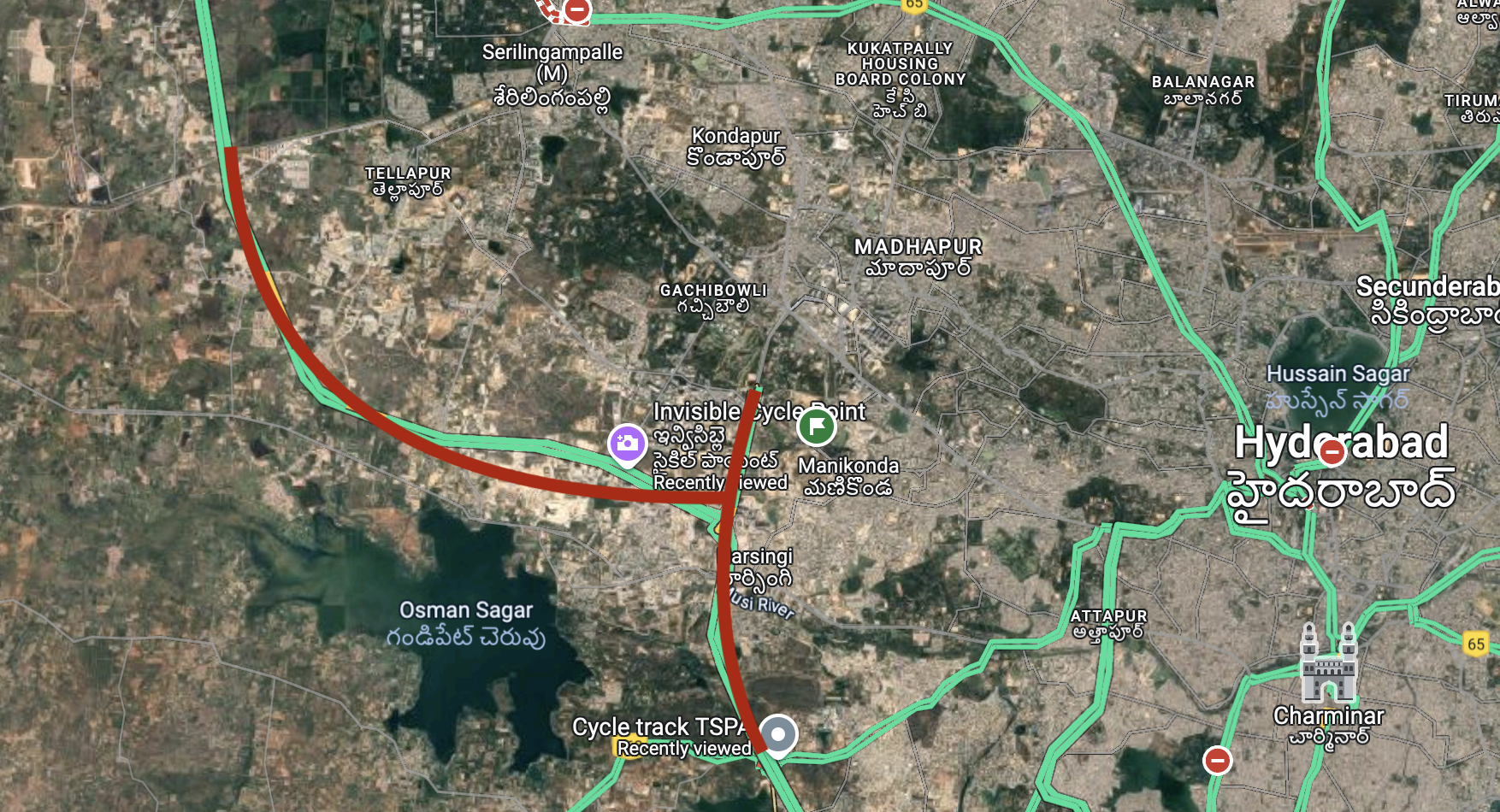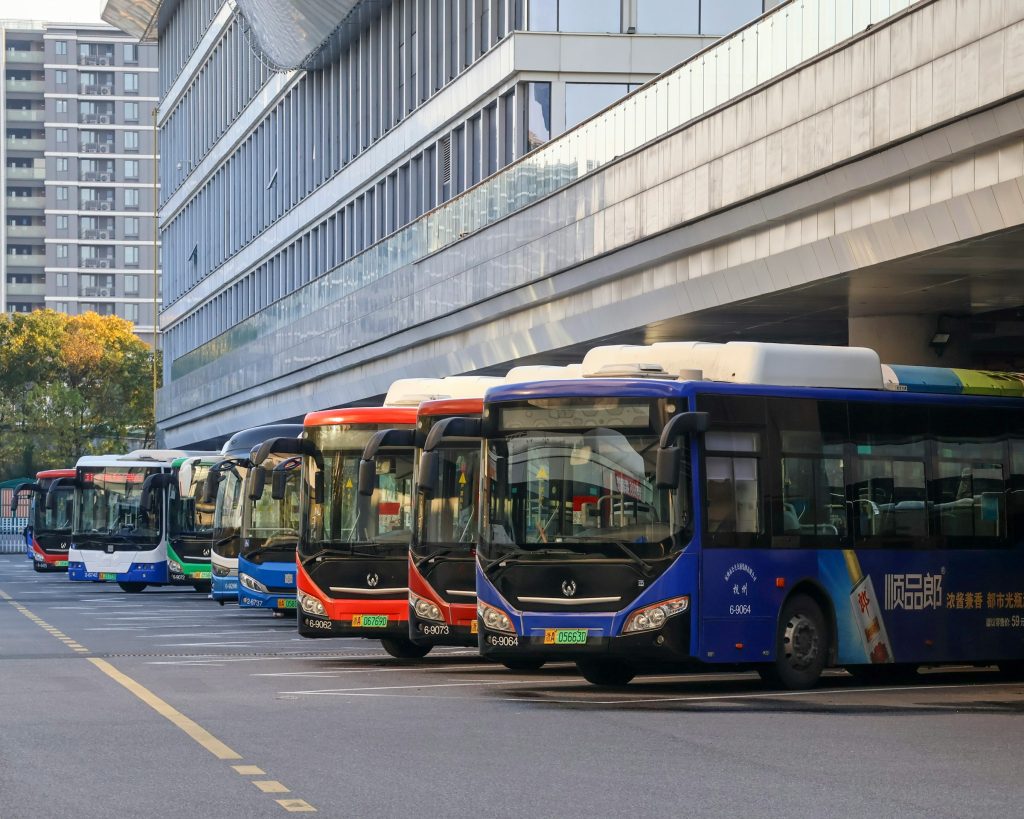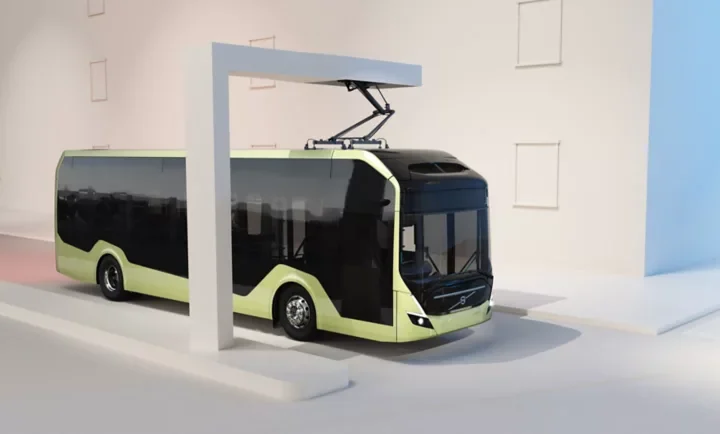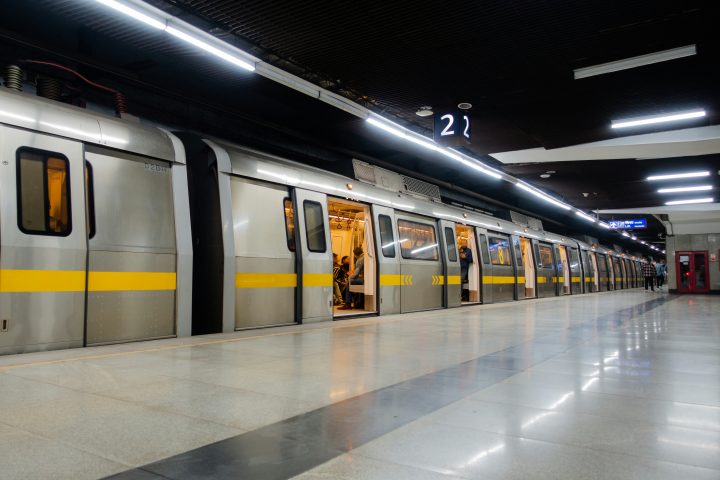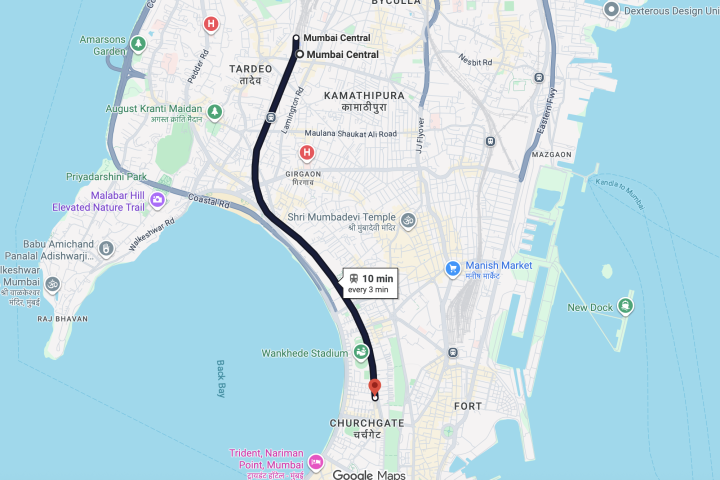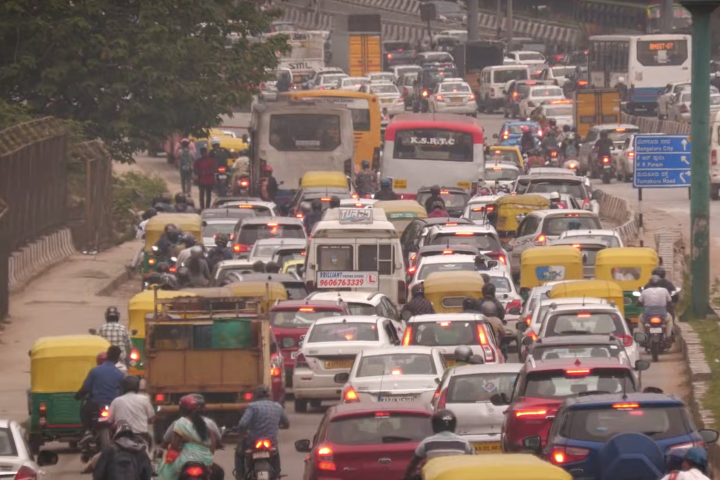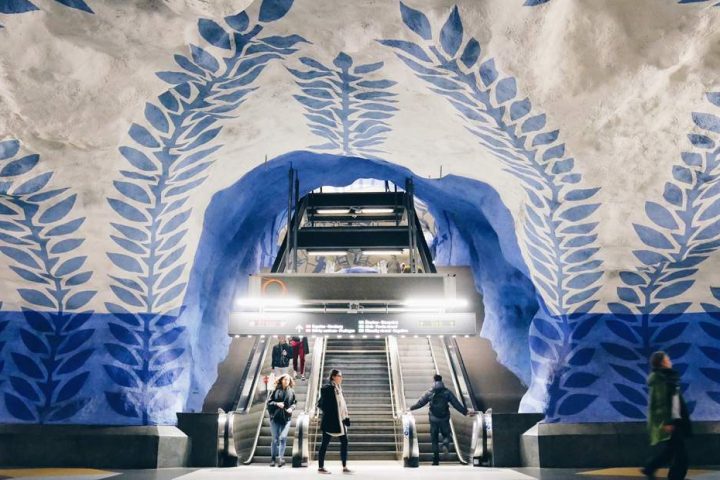In 2019, Norwegian diplomat Erik Solheim tweeted a video of a cycling track in South Korea, which was built on one of the highways, and was also covered by solar panels.

This tweet caught the attention of then Municipal Administration and Urban Development Minister, KT Rama Rao, who expressed interest in implementing such a track in the capital city of Hyderabad.
Work on this project began in middle of 2022, after two routes were identified as suitable for it.

It was officially thrown open to public in Oct 2023, featuring a three-laned design, and a 16 MW solar power-generating capacity.
It was named “Healthway”, and offered two lines – a pink line stretching from Nanakramguda to Telangana State Police Academy (TSPA) spanning 8.5 km, and the blue line stretching from Narsinghi hub to Kollur spanning 14.5km.
Since its inception, the track has received mixed reactions from the public. Vocal supporters praise for its sustainability, clean energy, and healthier lifestyles. On the other hand, critics argue that the project is a wasteful expenditure, citing its high costs and questioning its practicality and usage levels.
Positives
Well built track: Despite its flaws, which I will highlight below, the track was constructed with good intentions. It is wide enough, and offers a high quality community space for the city’s residents.
Introduces and encourages cycling: Indians like to cycle, and this track allows people of all ages to try it. It allows them to experience the joy and freedom of cycling more frequently than before.
Decently maintained: The municipality seems to take pride in the track, ensuring it is well-maintained throughout the year. Unlike some other cycling tracks in the city, this stretch gets more care and attention.
Integration of Solar cells: The solar cell roof integration with the track is quite ingenious and practical, even though they may have borrowed the idea from Korea. It serves as a source of energy, optimizes land usage by eliminating the need for separate solar panel installations, and offers much-needed shade from scorching Indian heat.
Political will: To take an idea, and implement it in Indian conditions is quite remarkable nonetheless – especially cycling related infrastructure, which receives little to no support from politicians and policy makers.
That said, I would like to share some criticisms, as the track has a few fundamental issues, in my opinion.
Wrong inspiration
The South Korean track connects two urban centers, Sejong and Daejeon. The goal of the planners was to provide a sustainable and environmentally friendly way to travel between the cities, especially given the high volume of car usage on this highway.
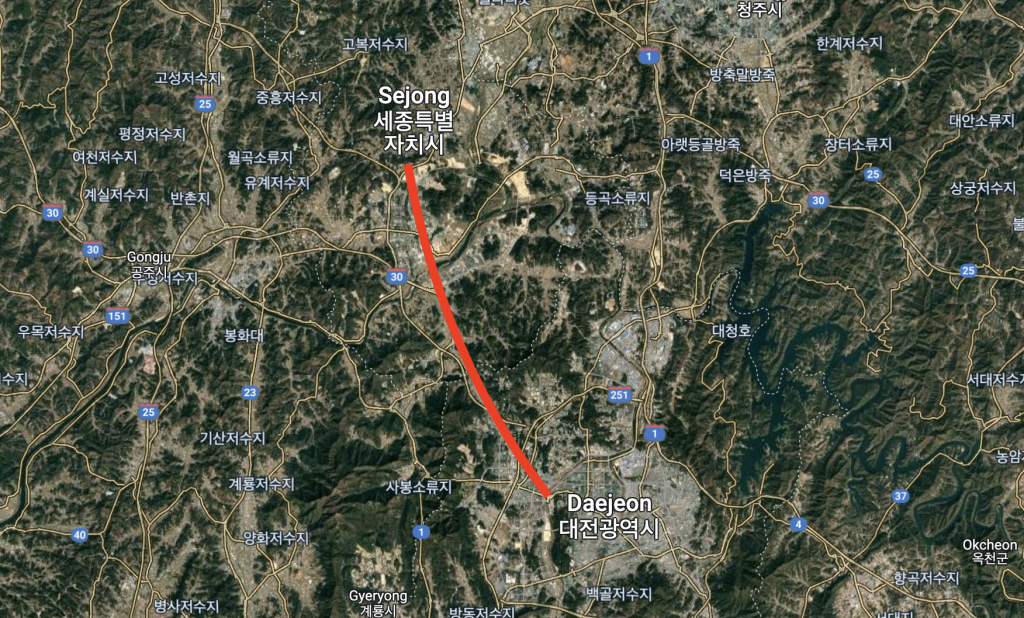
The track is built along the median of a six-lane highway that connects these two cities. As a result, cyclists have to climb flyover ramps every few kilometers, making it much harder to pedal.

Cycling is an intensive activity that requires steady supply of fresh oxygen to support the body. However, cyclists on this track are exposed to fumes from cars and trucks that pass in large numbers – both on the right, and on the left.
The setup and design of this track is so unconventional that there aren’t many places in this world that have built something like this.
Highly unsafe
The highways demand road discipline and safe driving habits from all motorists. Speeds can easily exceed 100 kmph on straight stretches.
While the Korean track is protected by crash barriers on both sides, cars can still intrude into these barriers and enter the cycling lane, as demonstrated in the video below.
Now, imagine a 5-tonne truck hurtling towards the crash barrier instead of a car.
Hyderabad’s case is even worse.
Indian drivers are notorious for bad driving habits and speeding, with little regard for traffic rules. Furthermore, the track has no crash barrier protection to protect cyclists from passing vehicles. Since its opening, several cars and trucks have crashed into the track damaging the solar roof and endangering cyclists.
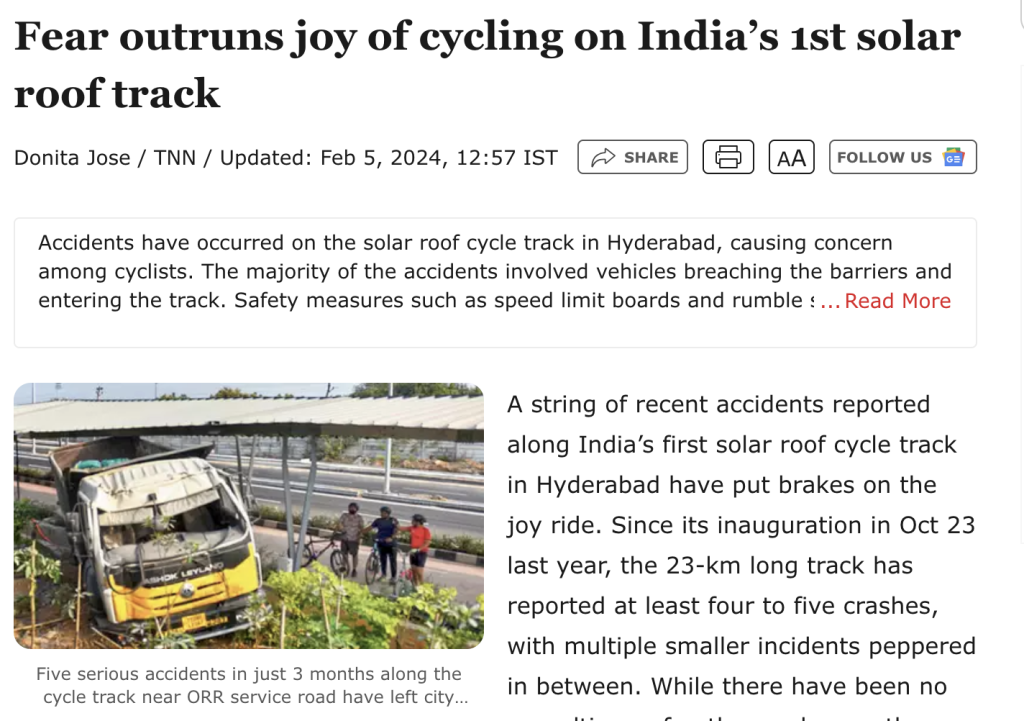
The primary cause of crashes is speeding, and since it is a major road, enforcing speed limits will be challenging.

After multiple crashes, Hyderabad Metropolitan Development Authority (HMDA) has promised to install crash barriers along the cycle track from Nanakramguda to TGPA and from Narsingi to Kollur. But as seen in the video above, this may not be sufficient.
So, how should it be built to ensure safety and effectiveness?
Here is the recommendation from MakingSpaceForCycling.Org, which is also endorsed by several leading cycling organizations in UK.
- Cycle tracks along major roads must always be fully segregated with a distance of between 4 and 8 metres from the main carriageway.
- Major roads unfortunately provide barriers to permeability and therefore cycle tracks should be built on both sides of a major road where there are few places to cross safely.
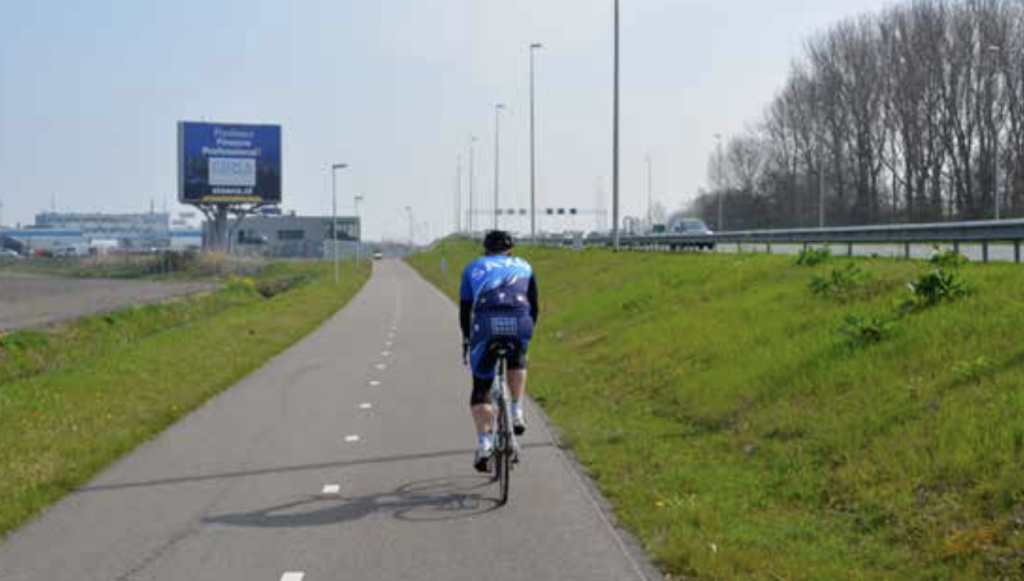
There are long stretches of road where the separation between carriageway and the track is almost negligible.
Here is an example.
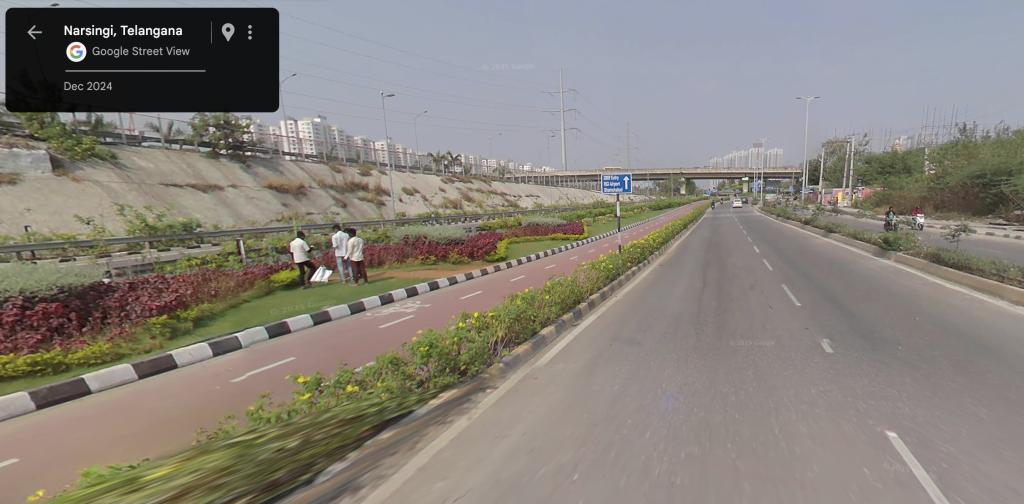
Made for the Daylight (only)
Few sections of road have little to no human activity. I wouldn’t be surprised if cyclists avoid using it after sunset.

In 1971, Professor C Ray Jeffrey developed an urban planning model called Crime Prevention Through Environmental Design (CPTED).
He recommended 4 steps to prevent crime in a city:
Access control/ target hardening: Limiting entry and exit points to reduce opportunities for unauthorized individuals to enter certain areas.
Natural surveillance: The diagram illustrates this point. Increasing visibility in public spaces by using proper lighting, open layouts, and strategic placement of windows, allows people to monitor their surroundings and discourages criminal behavior due to fear of being observed.
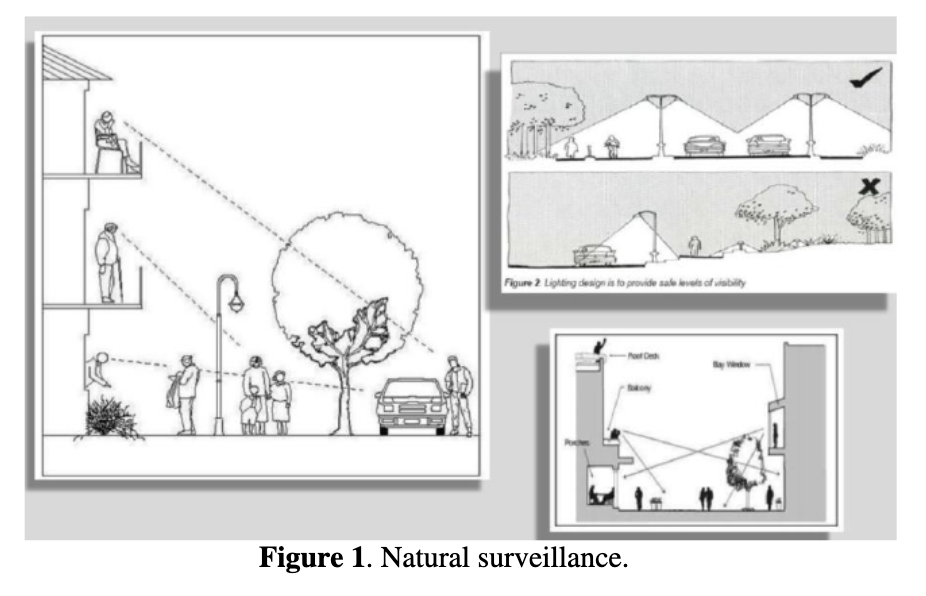
Territorial reinforcement: Design streets, and houses to encourage social interaction between neighbors, and creating spaces to create a sense of ownership among residents or users.
Maintenance and management: Public areas that are unmaintained encourage criminal behavior.
Since this track doesn’t adhere to these key points, its usage is limited to specific sections and largely confined to daylight hours, further reducing its accessibility and safety for cyclists.
Wrong implementation
The Korean cycling track addresses a real-world problem, with sufficient traffic between the cities of Sejong and Daejeon to justify its construction.
On the contrary, the Hyderabad’s track connects trivial points that are far from human habitation.
Take for example, the below entry/exit point located at a major highway intersection. Areas like this have very low population density, and one would have to travel several kilometers to reach this access point. Although the track has five access points in total, it still falls short.
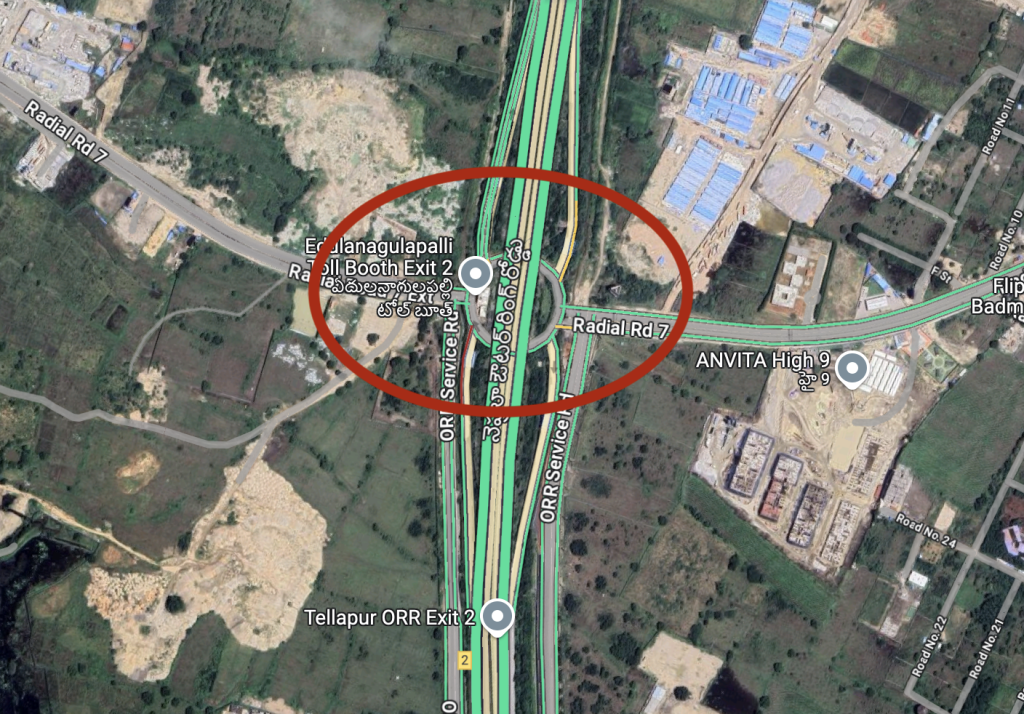
Users on Hyderabad’s subreddit have expressed similar views on this issue.


Wrong positioning
It is named “The Healthway Cycling Track” for probably two reasons.
- It is not a viable commute option for many.
- Authorities see cycling only for adventure/health benefits.
Since the area where this is built is still urbanizing, it offers commute options for a limited number of people, and also, cycling is often viewed as a way to stay fit rather than a practical mode of transportation by politicians and policymakers across India.
Here is our country’s sports minister promoting cycling during “Fit India Movement” this year.
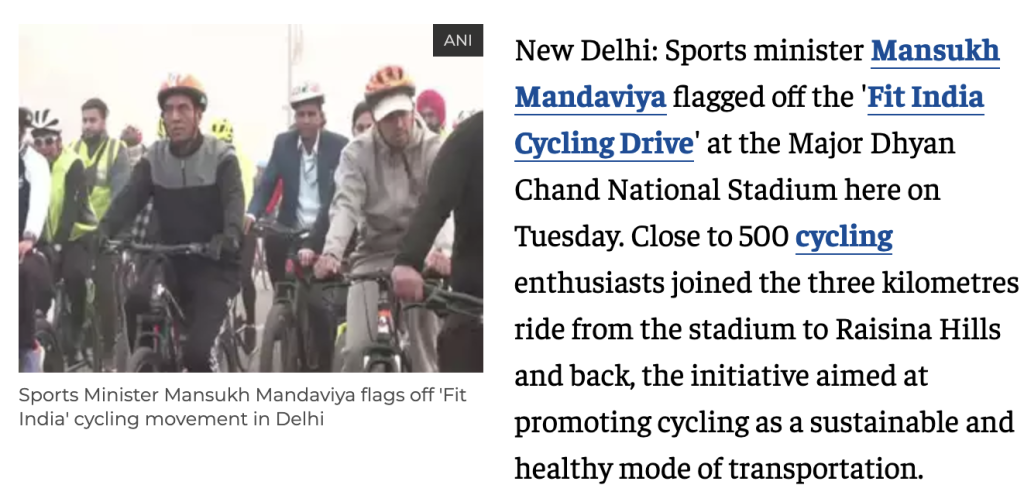
And here is KTR himself promoting it as a solution to control lifestyle diseases.

Lack of Network
Cycle lanes work best when they form a comprehensive network. I like to imagine it as a network of streams and rivers, with main routes (like big rivers) connecting the city’s major areas and smaller routes (like tributaries) feeding into them from neighborhoods and local streets.
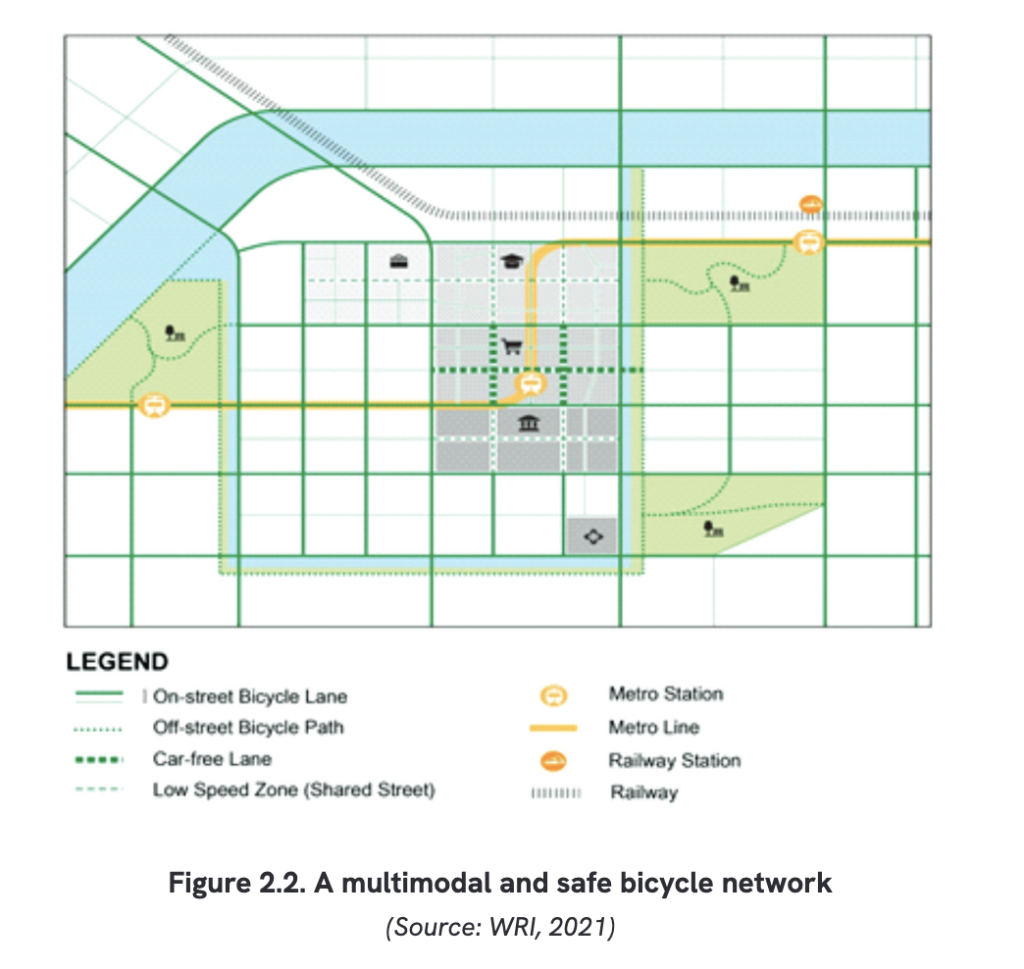
Several Reddit users have highlighted similar issues with Hyderabad’s standalone cycling track.

This isolated piece of strip is not connected to any existing cycle lanes and lacks seamless connectivity for city dwellers. As a result, the track is unusable for many, and authorities have not hesitated to replace it with car-centric infrastructure.
According to news reports, “Shade over the cycle track was removed to make way for a ramp which was scheduled to be constructed in view of the traffic slowdown near the Nanakramguda interchange.”
Same mistakes are being repeated
The authorities in Hyderabad are making the same mistake again with newer tracks.
- Cycling is being marketed as something to do at specific locations.
- Focus on health and leisure.
- Failing to create a comprehensive network by connecting with existing cycling lanes.
According to media, 46 km of cycling track is being planned around the Gandipet Lake.

In Oct 2024, Times of India reported that the Hyderabad Unified Metropolitan Transport Authority is planning to construct 10 km cycling track around the periphery of Hussainsagar lake.
Such isolated tracks are bound to meet the same fate.

Ignores the poor and the women
I spent over 60 minutes watching multiple Youtube videos to see if lower-income individuals actually use this cycle track.
I would love to be corrected on this, but unfortunately I did not notice anybody. It appears that this is exclusively built to cater to the upper-middle class. The problem is that, India has a long history of cycling with two distinct types of cyclists: The affluent urban cyclist, and the traditional lower-income cyclist.
It appears that this was primarily built for the former.
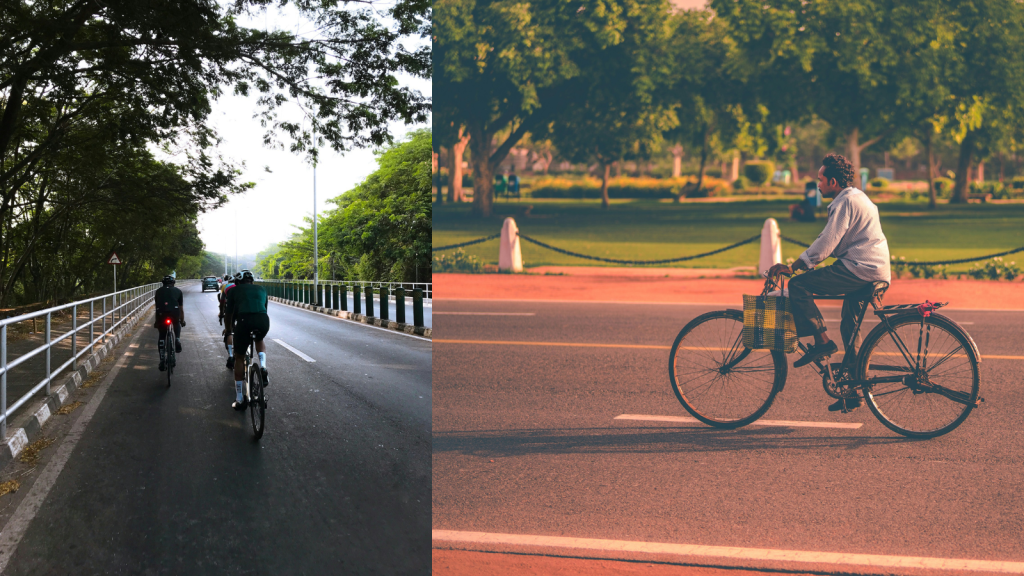
Also, women have been historically cycled less than men across all the states in India.
A 2018 study conducted by IIT Delhi highlights some interesting facts.
- The larger portion of Indian workers travel on foot or by bicycle (58.1% and 48.9% workers in rural and urban areas, respectively).
- Though women workers have higher mode share of pedestrians, only 4.5% women workers ride bicycle to reach their job locations as compared to 20.2% men in urban areas.
Building such long stretches can potentially be more unsafe for women compared to men, making them less useful for half of the population. This ties back to my point about how to make streets safer for everyone.
Deforestation?
Activist and founder of Vata Foundation P. Uday Krishna, alleged(reported in Th Hindu) that thousands, if not lakhs, of trees and saplings planted along the Outer Ring Road, may have been removed to make way for expansion of the service road and the solar-roofed cycling track.
Authorities have strongly denied having removed any greenery on the stretch. However, if this allegation is even partially true, it would be quite ironic.

Impact of urbanization
Currently, the area where this track is located isn’t densely populated. As more people move in, the pressure on the existing infrastructure will begin to show

Drainage systems need to be upgraded to increase capacity, and shops and other commercial activities may emerge along the track. Roadside vendors and mobile carts could appear overnight once they notice enough people with disposable income. Garbage collection and disposal will also become crucial.
The city municipality must urgently address these issues before it’s too late.
More harm than good
Critics will use the failure and poor response to this track as a reason to avoid building or expanding cycling infrastructure in the country. However, India, like every other nation, is transitioning from fossil fuels to more sustainable modes of transport. Haphazard implementation like this does more harm than good.
Moreover, a few cities might be tempted to build similar piecemeal solutions, as we lack enough examples of effective cycling infrastructure.
New Metro line could have helped but..
An Airport Express Line was proposed in 2022 which would connect the city to the airport. But it was later dropped in January 2024 in favor of a new route. The image below shows the older line, which would have run along the same route as the cycling track.

Below is the latest proposed route of Phase 2, which skips the outer ring road and instead uses a completely different route to connect the city with the airport.

Had the original route been retained, the cycling track could have benefited significantly. More people would likely have used it at various sections, increasing foot traffic, which in turn would have enhanced safety and reduced the risk of crime.
Additionally, it would have allowed people to carry foldable bicycles on the metro, further promoting cycling as a viable mode of transport.
Can it be salvaged?
To ensure I was not biased or uninformed, I posted this question on X.

Here are some of the responses I received.
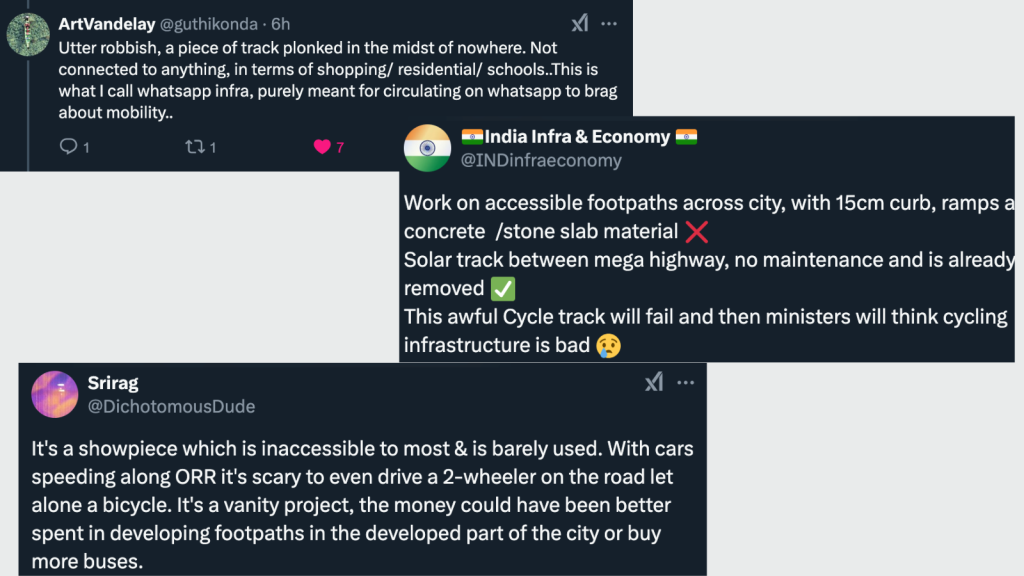
It seems that people generally share the same sentiment.
In Oct 2024, Deccan Chronicle reported that cycling has failed to take off, primarily due to the reasons I mentioned above.

In Jan 2025, the same media outlet reported, “The cycle track was inaugurated last October and it was used by few cyclists and that too in the mornings. It is only in the last four weeks that the figure has risen to 400 cyclists. Thanks to the rental facility, the weekends see a turnout of 600 persons.”
How to fix it then?
I recommend the following measures to improve safety and make the track more attractive to cyclists:
- Enforce lower speeds at specific stretches, and introduce traffic-calming measures to ensure safer cycling conditions..
- Increase surveillance and monitoring along the track, along with stricter fines for vandalism and the destruction of public property to maintain the integrity of the space.
- Enforce the track with additional safety measures, besides adding a crash barrier.
- Connect the track to nearby schools, malls, and offices, and promote it as a viable commuting route, not just a recreational one.
- Take inspiration from successful cycling cities like Copenhagen and Amsterdam, which have already addressed many of the challenges related to cycling infrastructure.
- Address the challenges posed by rapid urbanization, including issues such as vendor zone allocation, drainage, and water supply.
- Involve the public in the design process through consultations, and engage mobility experts to provide feedback. Be open to criticism and use it to improve the track.
In conclusion, while the Healthway Cycling Track holds promise for promoting sustainable transportation, health, and leisure, its current design and implementation leave much to be desired. It’s crucial that authorities take action now to ensure the track’s future success and integrate cycling as a viable mode of transport in the city.
If you like this article, please follow Street Frontier on X and consider donating below:
